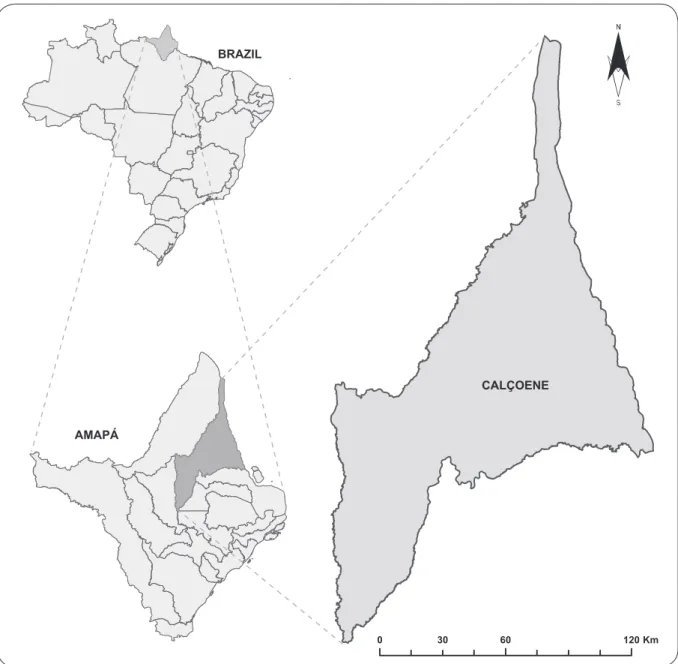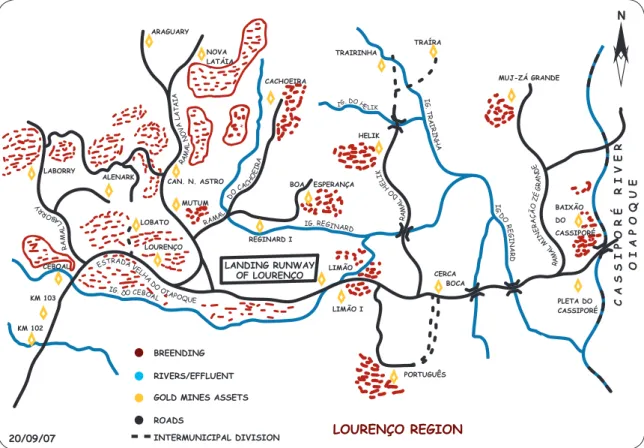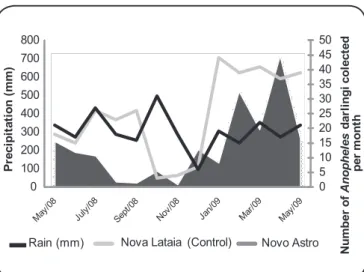Address to: Dr.Allan Kardec Ribeiro Galardo. Divisão de Zoologia/IEPA. Rodovia JK, Km 10, s/nº, Fazendinha, 68912-250 Macapá, AP, Brasil.
Phone: 55 96 3212-5353
e-mail: allan.galardo@iepa.ap.gov.br
Received 22 May 2012
Accepted 22 February 2013
http://dx.doi.org/10.1590/0037-8682-1649-2013
Major Article
INTRODUCTION
Larval control of
Anopheles (Nyssorhinchus) darlingi
using granular formulation of
Bacillus sphaericus
in abandoned gold-miners excavation pools in
the Brazilian Amazon Rainforest
Allan Kardec Ribeiro Galardo
[1], Robert Zimmerman
[2]and
Clícia Denis Galardo
[1][1]. Divisão de Zoologia, Instituto de Pesquisas Cientíicas e Tecnológicas do Estado do Amapá, Macapá, AP. [2]. Florida Medical Entomology Laboratory, University of Florida, Vero Beach, Florida, U.S.A.
ABSTRACT
Introduction: Use of a Bacillus sphaericus based mosquito larvicide was evaluated as an intervention for malaria vector control at a mining site in Amapá, Brazil. Impacts on larval and adult densities of the primary vector Anopheles darlingi were measured over the course of a 52 week study period. Methods: In Calçoene, State of Amapá, gold mining activity occurs in 19 mining sites in gold-miners of Lourenço. Large pools are formed in mining sites and naturally colonized by Anopheles darlingi. During one year, the impact of applications of VectoLex® CG to these larval sources was evaluated. Applications of 20kg/ha were made as needed, based on 10 immature (3rd, 4th instars and pupae) surveillance of health and established thresholds. Results: One hundred
percent initial control was observed 48h after each treatment. The pools received from 2-10 (5.3±1.6) treatments during the year. The average re-treatment interval in productive pools was 9.4±4.3 weeks. During weeks 3-52 of the study, mean density of late stage larvae was 78% and pupae were 93% lower in the treated pools than in untreated pools (p< 0.0001, n=51) while reduction of adult mosquitoes was 53% in comparison to the untreated area during the last ive months of the study, which were the rainy season (p<0.001). Conclusions: VectoLex® CG reduced immature Anopheles darlingi infestation levels during the entire study period, and reduced adult mosquito populations during the rainy season.
Keywords: Anopheles darlingi.Bacillus sphaericus. Gold-miners. Malaria.
Anopheles darlingi is the main vector of parasite of malaria in Brazil. Malaria transmission is primarily restricted to the Amazon region, and is prevalent in some states where settlements for gold mining have been established1. In the State
of Amapá 14.4% of the malaria cases in 2008 were associated with gold mining, 78% of which occurs in the municipality of Calçoene where the gold mining district of Lourenço2 is located.
The National Malaria Control Program (PNCM) guidelines are focused in early detection and treatment of cases, indoor residual spray (IRS) and more recently, insecticide treated nets (ITN), as key components of the strategy to reduce malaria transmission. In-house adult mosquito control strategies are central components of malaria vector control, but may not provide complete protection against transmission by exophagic and exophilic vectors including the An. darlingi in the Brazilian
Amazon3-6. Control of malaria vector populations through larval
source management (LSM) may substantially reduce adult malaria vector populations providing protection in addition to adult control measures7.
In Brazil, LSM is largely focused on environmental management such as drainage and illing of larval sources8. However, physical
measures are not always feasible, leaving many larval sources uncontrolled. Examples of such situations include ish ponds, residual mining pools, water reservoirs and natural wetlands. In these situations, the use of microbial larvicides such as Bacillus sphaericus (Bs) andBacillus thuringiensis israeliensis (Bti) may be useful components of LSM. The use of these larvicides has been shown to control anopheline mosquito populations, and reduce malaria transmission in Africa and Latin America7-14.
Extended control of An. darlingi larvae has been observed in ish ponds in Peru with VectoLex® CG, a 50 Bs International Toxin Units (ITU) granular formulation of B. sphaericus 2362 strain ABTS-174315. Residual control also has been observed
in natural breeding sites of An.albimanus in Colombia16, and of
An. braziliensis, An. marajoara and An. triannulatus in Venezuela17.
METHODS
Study area
The municipality of Calçoene was 227km north of Macapá, the capital of Amapá State (Figure 1). The climate was tropical and rainy, with a mean annual precipitation of 3,069mm and average temperature of 25.60C, with 75% relative humidity. The
study site was in the village of Lourenço, which is one of the 27 villages in the municipality that has extensive gold mining activity18. Gold mining occurred in 19 mining areas (Figure 2),
where gold extraction was performed through excavations and jets of water provided by pressure pumps. During the process of gold extraction large excavation pools were formed around the mining site. When these pools were abandoned, they were colonized by mosquito larvae, including An. darlingi, which
CALÇOENE
AMAPÁ
BRAZIL
0 30 60 120Km
FIGURE 1 - State of Amapá and the municipality of Calçoene.
was responsible for the maintenance of the malaria transmission among the mines’ workers, living near these pools (FUNASA, unpublished data).
Two mining sites were selected for the study - Novo Astro (treatment) and Nova Lataia (untreated control). The Novo Astro site was chosen for treatment, because it was an area with a history of a high incidence of malaria2.
Entomology surveys
FIGURE 2 - Drawing of the gold mining region of Lourenço in the municipality of Calçoene, State of Amapá. Yellow spots indicate active mining sites, and the red spots are Anopheles sp. larval sources. The study sites are represented in the box, Nova Lataia and Novo Astro.
Each technician followed a speciic method of work and a pre-determined schedule with rotation of sites to minimize bias. Mosquitoes were collected with a manual suction aspirator before they initiated a blood meal, and were transferred to the laboratory in labeled moisture chambers. Live specimens were anesthetized with ethyl acetate for further identiication. The species of subgenus Nyssorhinchus were identiied employing the taxonomic keys of Faran & Linthicum19 modified by
Voorham, and Consoli & Oliveira20
All 23 larval source in abandoned gold-miners excavationin the area, were evaluated individually, and records were kept of the larval survey results on the treatment date and post treatment evaluation (48h post treatment). Larval surveys were performed weekly one day per week in the 52 weeks, from 6h to 9h using a 5L dipper. Pond borders were marked every 5m with wooded sticks. These locations were sampled with nine dips per location during each sampling throughout the study period. Ponds with perimeter greater than 100m were sampled at a maximum of 20 locations. The number of immature Anopheles (larvae and pupae) collected in each dip was counted and recorded by instar stage (irst instars - L1, second instars - L2, third instars - L3, fourth instars - L4, and pupae).
Larval source treatment
Treatments were made using VectoLex® CG, manufactured by Valent BioSciences Corp., at the rate of 20kg/ha. The product was applied by hand, except for one large pool which was treated with a motorized backpack blower (Guarany®).
The pools were retreated when late instars (L3 and L4), and pupae were detected in numbers greater than 10 per sampling during weekly larval surveys.
Data analysis
Weekly counts of immature anopheline mosquitoes in 23 treated and untreated ponds were analyzed by life stage categories including early instars (L1 and L2), late instars (L3 and L4), and pupae. The average number of each stage collected in treated ponds (n=9) and untreated ponds (n=2) was calculated weekly. The means of weekly averages in treated and untreated ponds were analyzed across weeks 3 to 52 (n=51) of the study using both a z-test and an ANOVA in order to compare the number of immature stages collected during the entire treatment period. Adult landing collections in treated and untreated areas were similarly compared across time applying ANOVA to monthly collections in the dry season (May to December, n=7 months) and wet season (January to May, n=5 months). Correlation of adult population densities and rainfall in treated and untreated areas were evaluated using the correlation function of the MS Excel data pack (Pearson’s correlation coeficient).
Ethical considerations
RESUlTS
TABLE 1 - Larval sites and amount of VectoLex CG used at the Lourenço gold mine area
Area VectoLex Number Total Site (1,000m²) CG (Kg) of treatments (Kg)
Untreated 1 75 - -
-Untreated 2 5.2 - -
-2 1.3 2.6 9 23.4
3 12 24 9 216
5 3.5 7 7 49
6 2.4 4.8 5 33.6
7 2.1 4.2 4 16.8
8 3.8 7.6 4 30.4
20 7.5 15 2 30
21 0.5 1 6 6
23 1.15 2.3 10 23
Total 39.5 68.5 5.3 428.2
Larval source treatments
From May 2008 to May 2009, 23 pools were selected and evaluated at the untreated site, Nova Lataia. Only nine pools at the Novo Astro site (area under treatment) produced Anopheles
larvae during the study period. The other sites dried out during the study or were not productive due to pollution from mining activities, inhibiting mosquito development.
The number of treatments and consumption of the Bacillus sphaericus formulation is presented in Table 1. Of the 23 pools monitored only nine required treatment. All treatments resulted in 100% larval reduction 48h post-treatment. Most treated sites had received initial treatment by week 2 of the study. Based on the established treatment thresholds and surveillance, an overall average treatment interval in the active sites following initial treatment was 9.4 (± 4.3) weeks. Active sites required an average of 5.3±1.6 treatments during the year. Sites 2 and 3 received nine treatments during the year and the remaining sites required between two and seven treatments.
Entomological outcomes
The impact of the VectoLex® CG treatment is shown in
Figure 3. The mean number of all stages was signiicantly lower in treated vs. untreated sites by both ANOVA (p <0.0001) and z-test (p < 0.0001). Immature densities tended to increase in the untreated pools, and decrease in the treated pools. The total number of all immature stages of anophelines was 80% lower in treated pools compared to untreated pools. The number of L1 and L2 larvae collected was 73% lower, the number of L3-L4 larvae was 78% lower, and pupae were 93% lower in treated compared to untreated pools. Pupal densities were highly
0 10 20 30 40 50 60 70 80 0 100 200 300 400 500 600 700 800 P re c ip it a ti o n ( m m ) Im m a tu re s s ta g e s
Rain Treatment Control
FIGURE 3 - Rainfall and number of immatures stages collected in the two areas studied in the community of Lourenço, Calçoene, State of Amapá.
suppressed in the treated pools from February to May 2009. In February 2009, the percent reduction in pupal density reached 100% and remained near zero for the remainder of the study.
During monthly mosquito capture sessions, two malaria vectors species were predominant all year, An. darlingi
presented in Figure 4. The number of adults captured in monthly surveys was positively correlated by Pearson’s correlation with rainfall in the untreated area (+0.52 correlation), correlated with rainfall in the treated area (-0.17 correlation coeficient). Reduction of the adult mosquito population in the Novo Astro site was detected during the suppression in the rainy season from January to June 2009, when a 53% (p<0.001) reduction in the number of An. darlingi captured was maintained throughout this period, in comparison with the untreated site, Nova Lataia. This observation is in agreement with the observed reduction of the production of the larvae and pupae shown in Figure 3.
10 0 5 10 15 20 25 30 35 40 45 50 0 100 200 300 400 500 600 700 800 P re c ip it a ti o n ( m m ) N u m b e r o f A n o p h e le s d a rl in g i c o le c te d p e r m o n th
Rain (mm) Nova Lataia (Control) Novo Astro
DISCUSSION
This year-long study is the irst work to evaluate the eficacy of surveillance-based Vectolex® CG applications for control of An. darlingi population densities over time. The results showed that it is feasible to maintain control of An. darlingi
population densities in a gold mining area. Late instar and pupal reductions indicated that after the third week of treatment, a signiicant level of control of immature life stages was reached and maintained throughout the study period. Also, beginning in February 2009 the production of pupae in the treated sites was suppressed to near zero; demonstrating that these larval sites were unproductive in the rainy season while the untreated control sites were highly productive.
The low mean number of required treatments per pool and the 9-week average re-treatment interval indicated that residual efficacy was achieved following VectoLex® CG treatment. This result is in agreement with results obtained following VectoLex® CG treatment of ish ponds for control of An. darlingi in Peru15, where a residual control of late instars
was observed for 45 days with a single application at the rate of 20kg/ha, same rate used in this study. Similar results were obtained in Colombia, where a 92% reduction in pupae of
An. albimanus was observed 33 days after treatment16, and in
the studies with anopheline vectors from Venezuela17,21, which
showed an eficacy of ~80% from 28 to 90 days after a single application of VectoLex® CG. The positive correlation of
An. darlingi abundance with rainfall in the untreated control sites suggests that the onset of the rainy season played a determinant role in the increase Anopheles abundance. This is in agreement with a recent study conducted in State of Amapá on the relationship between anophelines abundance and rainfall22. However, in the treated site, the negative correlation
between rainfall and number of mosquitoes collected indicated that the LSM strategy reduced the adult vector population even during the rainy season. Similar strategies have been proven successful in Tanzania14 and Kenya7 where the reduction in
entomology inoculation rates (EIR) and malaria transmission was demonstrated through the integration of microbial larvicides use with other interventions in large scale programs. The suppression of Anopheline populations demonstrated by the results obtained in this trial, suggest that sequential applications of VectoLex CG can be a powerful integrated vector management (IVM) tool for reducing human-vector contact in this environment.
It can be concluded that it is feasible to maintain control on
An. darlingi population densities in gold mining areas with a LSM program based on the use of microbial larvicides.
ACKNOWlEDGMENTS
The authors would like to thank team GIS Division and Technical entomology of the Centro de Pesquisas Zoobotânicas e Geológicas of the Instituto de Pesquisas Científicas e
Tecnológicas do Estado do Amapá Aderbal A. Santana,
Francisco Redivaldo A. Souza, Jorge P. Duarte and José Claudio C. Mendes. We also thank to Paulo de Tarso R. Vilarinhos for advising on the protocol and contributing to the edits of the article.
The authors declare that there is no conlict of interest.
CONFlICT OF INTEREST
FINANCIAl SUPPORT
This study was partially supported by Valent BioSciences Corporation.


